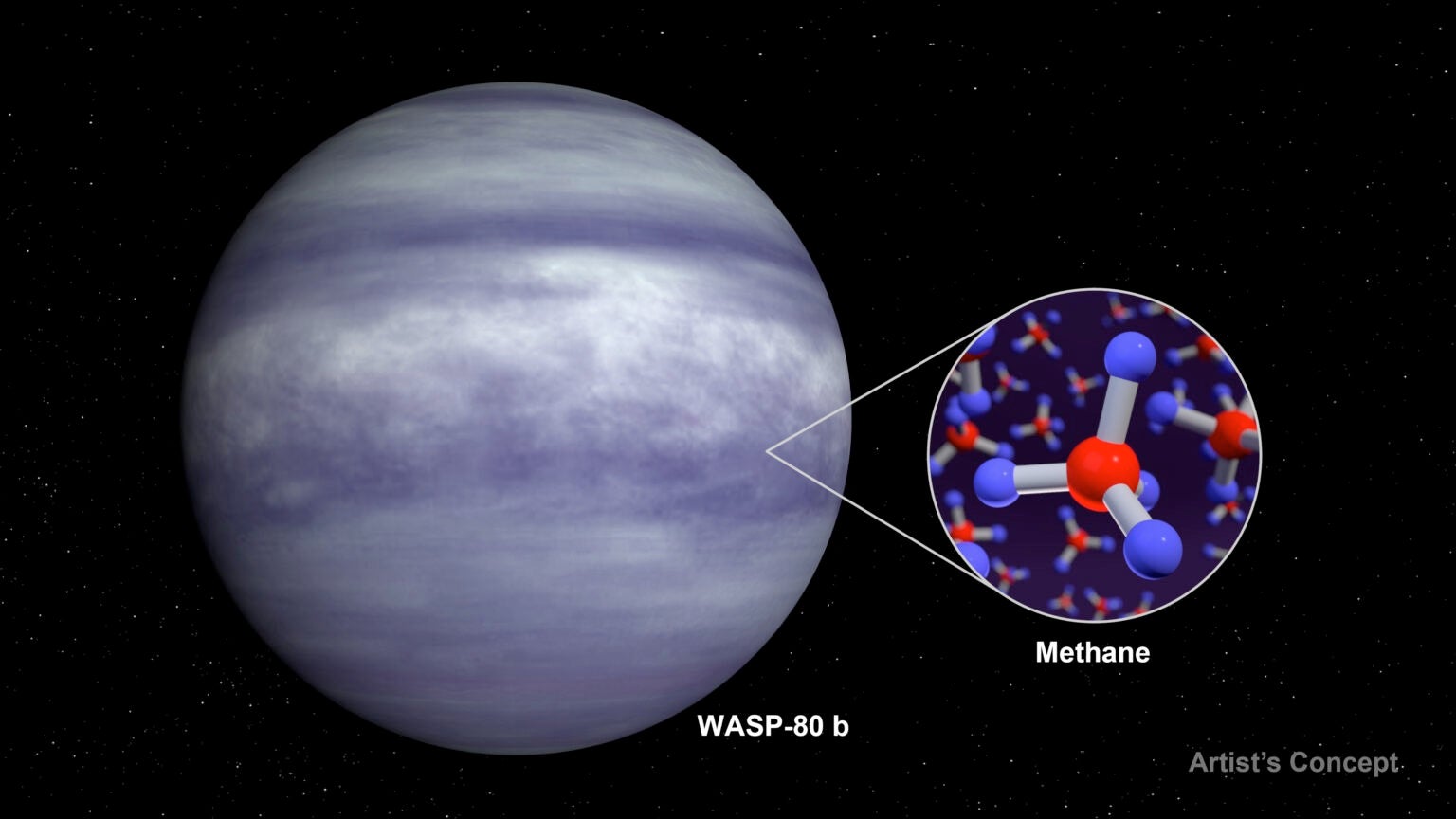
The James Webb Space Telescope (JWST) has just detected methane in the atmosphere of exoplanet WASP-80 b — and it has both little and everything to do with how we might someday find life in the cosmos.
In research published Nov. 22 in Nature, a NASA-affiliated team reported the detection of methane in the atmosphere of WASP-80 b. The planet is as inhospitable as they come, about half the mass of Jupiter and roughly its size, but orbiting its star (which is smaller than the Sun) in just three days. The world’s average temperature is some 1,025 degrees Fahrenheit (552 degrees Celsius). It’s not the hottest known planet by any stretch, but that’s not a comfortable temperature for any living cell.
Which is to say, none of the methane in its atmosphere was produced by life. The science on that is pretty confident, given that all our giant planets have methane too. There, solar radiation reacting with carbon and hydrogen in the presence of oxygen creates methane (CH4), which is relatively stable in the conditions found in these planets’ thick atmospheres.
On Earth, this isn’t the case. Methane tends to destabilize very quickly in our atmosphere, so any present is mostly produced by living things. This is why astronomers want to use it as a biosignature, or sign of life, when looking for habitable planets around other stars.
But WASP-80 b is nothing like Earth, and natural forces produced its methane. So, why is the find important? Because spotting methane in exoplanets’ atmospheres is challenging and hasn’t been done many times before. So, finding methane in the atmosphere of any exoplanet shows we can find it at all, and provides a good roadmap for how to do it.
It also allows researchers to use this “elusive” molecule to study how planets form and evolve. “Now we will really be able to see, where do methane and all these other important molecules form in planetary atmospheres and how do planets compare to each other?” says study first author Taylor Bell, a postdoc at the Bay Area Environmental Research Institute.
Tracking transits
The detection was made by watching WASP-80 b transit in front of its star. This creates a mini-eclipse of the star that causes a noticeable dip in its light. In the case of WASP-80 b, the transit is fairly profound. That’s because the difference in mass and radius between the planet and star is relatively small. In fact, planets this size aren’t normally found around stars as small as WASP-80, making it an “exceptionally rare” exoplanet, according to Bell.
But that also makes it an easy target for JWST, which uses its instruments to observe the way light filters through the atmosphere of the planet during a transit. That, in turn, can reveal the fingerprints of the chemicals present in the planet’s atmosphere — this is how methane was discovered.
Now, JWST can turn its instruments toward other planets as well. One example is K2-18 b, an exoplanet where researchers recently discovered not only methane but also dimethyl sulfide, which on Earth can only be produced by life. But even that is still far from a given sign of life, as that planet is more than eight times as massive as Earth, and more than twice as large.
Nonetheless, observations like those at WASP-80 b and K2-18 b could show how methane forms in exoplanets and stays stable there, which is important for understanding whether it is a sign of life or not.
It can also prepare us for finding methane in the atmosphere of a smaller, rocky world where we wouldn’t expect it without life — such as TRAPPIST-1’s bevy of planets. Although these planets’ thinner atmospheres are harder to probe, if methane is discovered, astronomers could use the other chemicals discovered alongside it to determine how methane is produced there, giving us a better sense of how and when it formed — and when it’s a fingerprint for life versus simply a sign of the right natural (but lifeless) environmental conditions.
JWST is the also first telescope really equipped to find methane, with its huge light-gathering power and ability to see deeper into the infrared, where it’s best to probe exoplanet atmospheres, than Spitzer or Hubble. While both these telescopes found it in brown dwarfs — an object neither planet nor star — “all attempts to try and find methane in transiting exoplanet atmospheres” came up short with either telescope.
“It’s a relatively simple molecule. We should see it in at least some planets,” Bell says of methane. Now, we’re starting to.
These results — along with the lack of results from Hubble and Spitzer — also show that “it’s potentially indicative that methane in exoplanet atmospheres is maybe a little bit more fragile than we thought it was,” Bell says.
Now we just need to find methane in more places. Only then will we begin to get a picture of how and when it forms, and what it means for life.









